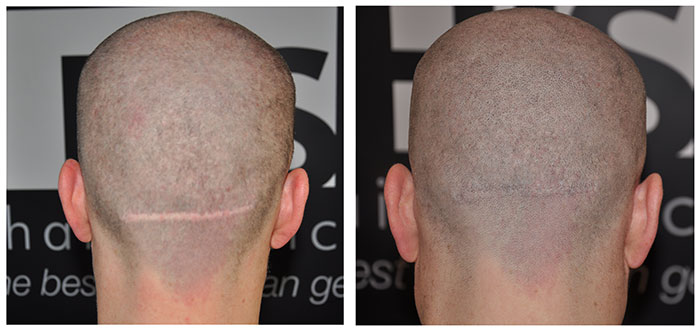The presence of a scar can be either a reminder of a painful experience or a badge of honor recognizing the survival of trauma forever marked, but still alive. But for past hair transplant recipients, the scar is just an unfortunate reality — it just comes with the territory, sort of speak, with the procedure.
And for over a decade, clients have sought out HIS Hair for a solution to camouflaging and concealing the scars on their scalps. In this time, HIS Hair has firmly established itself as global leader in the scalp pigmentation industry, a reputation that we are proud to earn. But as much as reputation is built on the success of our SMP treatments, scar coverage and camouflage has become something of an added specialty for us.
HIS Hair practitioners have treated scars in every shape, form and size, whether it be a standard linear scar left behind from a hair transplant, an injury scar on the scalp of a solider earned in the heat of battle, or surgical scar. The practitioners at HIS Hair are more than prepared and experienced in the art of SMP for scar camouflaging and obscuration.
But with that, there is always skepticism on the part of the potential client, especially those looking into scalp pigmentation for scar coverage. Clients exploring this as an option are often clients coming to HIS Hair after a failed hair transplant and already know disappointment when it comes to hair loss solutions. Our goal with this next series is to share how we do what we with regards to SMP and scar coverage.
In the next two articles to follow, we will cover what is a scar, how the skin creates a scar after a trauma to the skin, and discuss the technique that HIS Hair practitioners apply when working with camouflaging a scar. We will walk through how the technique and approach to a SMP for scar coverage is slightly different than the approach and technique to a standard hair loss treatment.
What makes HIS Hair’s scalp pigmentation on a scar a slightly different approach with regards to the treatment plan and approach? For example, every client undergoing a scalp pigmentation procedure with HIS Hair requires a minimum of two sessions to start, but clients looking to have treatment done on the scar will require a minimum of three sessions. Why?
Simply put, the damaged skin of a scar requires more work and attention then that of a treatment on a healthy, undamaged skin. Healthy skin, wherever it may be on the scalp (hairline, crown, back, temples, etc.), will always receive the pigment easier than that of the damaged skin. What is it about damaged skin that makes it more difficult? We will cover that in more detail in the upcoming articles.
Be sure to stay plugged in; follow us on Facebook and twitter for announcement of when those articles are published, plus info on all things HIS Hair.

